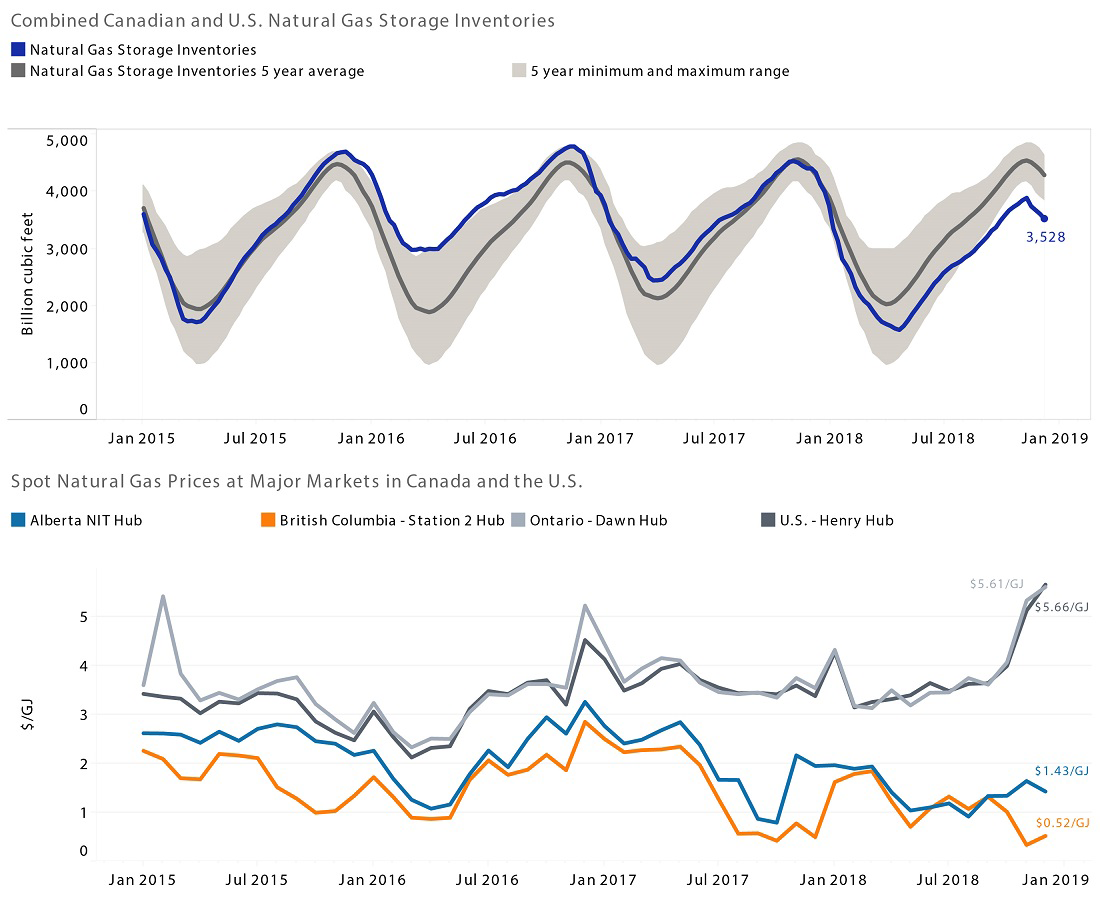Market Snapshot: 2018 North American natural gas market summary and storage update
Release date: 2018-12-19
The North American natural gas market is closely interconnected via pipelines. Supply or demand events in one region often impact prices elsewhere. For this reason, analysis of the Canadian natural gas market happens in the context of North America (Canada and the United States (U.S.); and increasingly Mexico).
2018 marked several major milestones in the North American natural gas market. Combined Canadian and U.S. natural gas production reached a record high in August, when production reached 101 billion cubic feet per day (Bcf/d)Footnote 1. Demand also saw a record high in 2018 when it increased to 121 Bcf/d in January 2018Footnote 2. Natural gas storage is used to balance the market when demand is greater than supply.
High U.S. demand is being driven by power generation and growing exports. Natural gas usage for power generation peaked in JulyFootnote 3, U.S. exports to Mexico reached a record 5 Bcf/d in AugustFootnote 4 and U.S. exported a record high of 2.8 Bcf/d from two liquefied natural gas export facilitiesFootnote 5.

Source and Description
Source: Canadian Enerdata, U.S. Energy Information Administration’s Weekly Natural Gas Storage Report, ICE NGX
Description: The first graph shows combined monthly natural gas storage inventories in Canada and the U.S., the 5 year average for January 2015 to December 2018 and the 5 year minimum and maximum range. At the beginning of December 2018, natural gas storage totaled 3 528 Bcf. The second graph shows monthly average natural gas prices at key hubs in Canada (Alberta NIT hub, British Columbia Station 2 hub and Ontario Dawn hub). For December 2018, natural gas prices in British Columbia averaged $0.52/GJ, $$1.42/GJ in Alberta, $5.65/GJ at Henry Hub in the US and $5.61/GJ in Ontario.
Due to record high natural gas demand in 2018, combined Canadian and U.S. natural gas storage levels are below the 5 year minimum heading into 2019. As of 7 December 2018, storage inventories totalled 3 528 Bcf; 18% below the 5 year average and 8% below the 5 year minimum. Low storage, in combination with a ramp-up of seasonal space heating demand, resulted in a natural gas commodity price increase in November and December.
In Canada, monthly average natural gas prices increased to $5.61 per gigajoule (GJ) in Ontario in December; an increase of 47% from the 2018 12 month annual average of $3.80/GJ. At the Alberta and northern British Columbia hubs natural gas prices remained low, due to production growth outpacing pipeline capacity takeaway expansions. In British Columbia’s Lower Mainland, FortisBC customers are encouraged to decrease their natural gas consumption, due to lower supply availability following a pipeline rupture north of Prince George. In the U.S., monthly average natural gas prices at the Henry Hub in Louisiana increased to $5.65/GJ in December.
According to the U.S. Energy Information Admnistration (EIA), growth in U.S. natural gas production will put downward pressure on prices in 2019. EIA forecasts Henry Hub natural gas spot prices to average $4.21/GJ in 2019. Canada’s Energy Future 2018 assumes that the Alberta natural gas price will average $2.15/GJ in 2019.
- Date modified:
